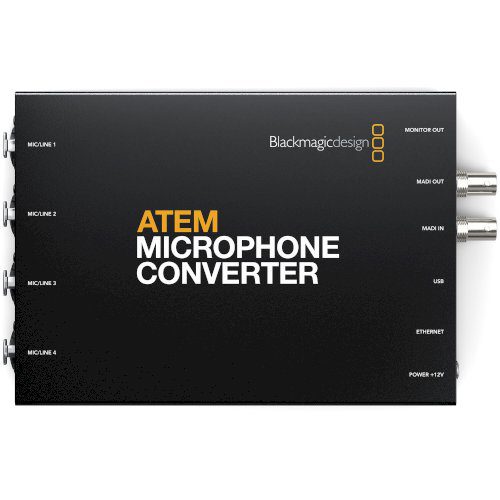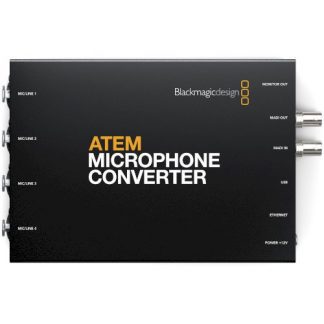Description
The Blackmagic Design ATEM Microphone Converter makes it easy to expand the MADI input on ATEM switchers so customers can add multiple microphones or external audio mixers. The unit simply plugs into the ATEM Television Studio MADI port, so there’s no complex setup required and additional units can even be daisy chained for more sources. Each converter has 4 analog inputs that are mic/line selectable and have 48V phantom power. The design features amazing audio quality with an extremely low noise floor, a wide dynamic range and very low distortion. The design even uses 8 separate ADCs on each separate input that works together to extend the dynamic range. There is also an HDMI monitoring output with scrolling audio waveforms.
The ATEM Microphone Converter features a familiar converter-based design that has space for the analog electronics required for high-quality analog-to-digital audio conversion (ADC). It features combined XLR/TRS input sockets allowing both XLR or jack cables to be connected. It also includes a MADI output with the converted audio, as well as a MADI input which allows multiple ATEM Microphone Converters to be daisy-chained so more than 4 channels of audio can be embedded into a single MADI connection.
The ATEM Microphone Converter’s MADI output embeds the 4 analog inputs as MADI channels 1, 2, 3 and 4. ATEM Microphone Converter also includes a MADI input, which is used to loop multiple converters when customers need more than 4 channels of audio on a single MADI link. This means if a second converter is connected to the input of another, the upstream converter will stack its 4 channels above the 4 channels on the downstream converter.
Each analog input channel has an ultra-low noise, fixed gain pre-amplifier scaled to drive a high dynamic range audio ADC, which totally eliminates using an analog microphone pre-amplifier in the design so the input does not suffer from preamp gain step clicks or “zipper noise”. The ATEM Microphone Converter steps outside the conventional audio industry design practice of using an individual audio ADC, as each input implements analog to digital conversion using 8 high dynamic range audio ADCs that function collectively as one ultra-high dynamic range audio ADC. This means each input channel’s dynamic range is an incredible 131 dB(A).
A common problem with mic converters is the higher noise floor where electrical noise is generated in the preamplifiers. The ATEM Microphone Converter eliminates this problem by using a very different design where the input is converted directly using its ultra-high dynamic range conversion so customers pass RAW audio to the switcher where the switcher can then apply as much gain as required for the correct audio level. This means customers don’t get an injection of noise caused by an analog gain stage, so customers get an extremely low fixed noise floor of -129dBV regardless of the digital gain applied.
With the wide dynamic range input that eliminates the need for an analog pre-amplifier, microphone levels are adjusted by a digital pre-amplifier gain stage that is extremely stable. Different microphone types and brands can vary widely in analog audio levels, so this digital gain stage allows compensation for the specific brand of microphone customers use. Best of all, the digital pre-amplifier is processed in the full internal 32-bit RAW audio bit depth, so users are adjusting with much greater precision than the MADI audio standard can support.
The innovative design of the ATEM Microphone Converter also has other benefits, such as extremely precise matching between input audio channels. The multi ADC per input design technique means that each analog audio input has very similar specifications and tolerances so all input channels are statistically more uniform. Plus the unique 8 ADC input design will maintain a stable and consistent flat noise floor that won’t experience the negative effects of noise floor level modulation that traditional staggered ADC designs suffer from.
ATEM Microphone Converter also includes an HDMI video monitoring output so customers can connect a simple TV or computer monitor for a full status display. It includes 4 scrolling waveforms over the last 60 seconds of time, which is both informative and fun to watch. There are also audio meters to show the level at the input connector. There are also indicators to show the switch settings for mic/line input selection and phantom power. Plus if customers daisy chain converters the monitoring output will adapt and display more than 4 channels.




